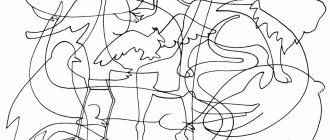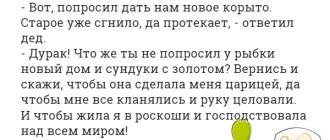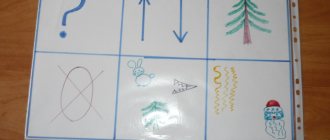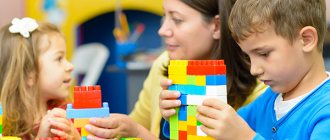- Development from A to Z
Each of us remembers how his mother taught him in childhood: “Be careful! Do not be distracted!". Whether it was crossing the road or doing homework, parents placed importance on how attentive their children were. Why?
In fact, the demands of adults are not unfounded, because attention is one of the main cognitive mental processes of a person, without which successful study at school, university, and then professional activity is impossible. That is why, even a year before the child enters first grade, it is recommended to identify the current level of development of the child’s attention and, if necessary, prepare the child with the help of games and exercises that develop attention.
Attention tests for preschoolers
Test first
Look carefully at the following picture, geometric shapes are depicted here in different ways. You have one minute to complete this test. Find identical geometric shapes.
If you couldn’t find the same geometric shapes in one minute, repeat the exercise.
Test two
Look carefully at the following picture, it shows different objects. You have one minute to complete this test. Find two extra pictures among all the pictures.
Test three
Look carefully at all four pictures, different objects, clothes and vegetables are drawn on them. You have one minute to complete this test. Find the extra object in each square.
Test four
Look carefully at this test, a rectangle is drawn here with a certain pattern, but not completely. You have ten seconds to complete this test. Which figure and under which number should be inserted.
Test five
Look carefully at the following picture. Here children are depicted and letters are written. You have one minute to complete this test. Decipher the children's names using letters and say their names.
Test six
Look carefully at the following picture, here are drawn: a square, a triangle, a circle and a rhombus.
In the top line there are samples according to which you need to fill in all the other geometric shapes. There is a checkmark in the square, a minus sign in the triangle, a plus sign in the circle, and a dot in the diamond. One minute is given to complete the task.
Test seven
Look carefully at the next test, there is a car drawn here and a flag that indicates the finish. Ten seconds are given to complete the task. We need to bring the car to the finish line.
Test eight
Pattern test.
Look carefully at the pictures, different objects are depicted here. You have one minute to complete this test. In this test you need to find a pattern and draw the next or missing object.
Test nine
Look carefully at these two pictures. You have ten seconds to complete this test. Find ten differences in these pictures.
Test ten
Look carefully at the next maze, there is a monkey and a banana. You have one minute to complete this test. Help the monkey find a banana.
Test eleven
Pattern test.
Look carefully at the pictures, different objects are depicted here. You have one minute to complete this test. In this test you need to find a pattern and draw the next or missing object.
Test twelfth
This test contains a logical attention task. Look carefully at the top line, there is a number written under each picture. One minute is given to complete the task. You need to insert a number instead of a picture and calculate what happens.
Test thirteen
Look carefully at the pictures of this test; on the left there are samples with different pictures that need to be inserted into the right side of the picture. You have ten seconds to complete this test.
Look carefully at the pictures of this test; on the left there are samples with different pictures that need to be inserted into the right side of the picture. You have ten seconds to complete this test.
Test fourteen
Look carefully at the pictures of this test; on the right there are samples with different pictures that need to be inserted into the left side of the picture. You have two seconds to complete this test.
Test fifteen
Look carefully at the pictures of this test; there are teapots with different designs. You have two seconds to complete this test. Find two similar teapots.
Test sixteen
Attention test. Look at the picture of this test; there is a tree drawn on it; apples grow on this tree. The apples containing the “-” sign must be colored green, the rest must be colored red. You have three minutes to complete this test.
Test seventeen
Look at the picture of this test, vegetables, fruits, flowers, berries are drawn here and words are written. Match fruits with the word fruits, vegetables with the word vegetables, berries with the word berries, flowers with the word flowers. You have one minute to complete this test.
Test eighteen
Look carefully at this test, different animals and the foods they like to eat are drawn here. Help each animal find its food. You have two minutes to complete this test.
Test nineteen
Look carefully at this test, here are drawn Little Red Riding Hood, a wolf and the house where grandma lives. Help Little Red Riding Hood get to her grandmother's house so she doesn't get eaten by the wolf. You have one minute to complete this test.
Test twentieth
Look carefully at the next test, there is a drawing of a flower and a pot. You have one minute to complete this test. Find your way to the pot to plant the flower.
Test twenty-one
Pattern test.
Look carefully at the pictures, different objects are depicted here. You have one minute to complete this test. In this test you need to find a pattern and draw the next or missing object.
Exercises for preschoolers to develop attention and memory
First exercise “Remember and Tell”
In this exercise various objects are drawn. Look carefully at these items and remember them. The child is given ten seconds to memorize.
Now close the picture and tell from memory what is drawn here. Older children can draw these pictures from memory.
Second exercise “Name what you see”
Talk a lot and constantly with your child; the more he listens to you, the more he will concentrate on what you are telling him.
At home, you can show your child different objects, unusual objects, for example, a figurine. Tell us what kind of figurine it is, where you got it from, which figurine is big or small, who is depicted on the figurine, what material it is made of, the child will be interested in all this.
On the street at any time of the year, you can teach a child, tell what flowers are blooming, describe these flowers in more detail, what birds live in your city, and show them to the child, look at beautiful houses, fountains, monuments and so on.
The child gets to know the world around him together with you, he is interested in everything that you tell and show him, he loves to listen and touch.
Then you can take one thing, for example, a leaf from a tree and examine it carefully with your child. What leaf, from which tree, what color is the leaf, what size, and so on.
Third exercise “Tell and do”
It is very important to teach a child to concentrate on even the simplest task. Draw with your child together. Give your child a task to draw, for example, a house, sun and grass.
Explain to the child out loud what he should do first, correct him, pronounce every movement of the child. Communicate more with your child and comment out loud on his actions.
Teach your child to perform all actions sequentially. Gradually, the child will learn to do everything consistently, independently.
Fourth exercise “Find the object”
The game, find the object, is well suited for developing attention and memory. Come up with some object that is in the room so that the child knows this object well.
For example, it could be a doll.
Describe the doll in as much detail as possible, what it is like, what size and color it is, what can be done with this doll, what the doll is wearing, what kind of hair, eyes it has, and so on.
If the child quickly guesses what is being said, take another object and repeat the exercise.
Try to play the other way around, let the child come up with some object and describe it in detail, and you try to guess what kind of object it is.
Fifth exercise “Let's look at each other”
The exercise, let's see, looks at each other well, develops your child's attention and memory, it is very simple, interesting and fun. Your child will enjoy playing this game. You can play this game on the way to kindergarten, on the way to the store, and so on.
Give your child the opportunity to look at you carefully for a few seconds. Then he turns away and tells you everything he remembers about you.
For example, hair color, description of your face, what you are wearing, what color, and so on. If the child could not tell much, do not scold him, play this game again. Studying you, the second time the child will be more attentive than the first time.
You can even play this game in reverse, look at your child, turn away and describe what you remember. Your child will draw conclusions, he will compare your detailed description with his description and understand what he missed in the story. You can talk through these conclusions while delving into the details together.
Sixth exercise “Disturb me”
Interesting exercise, disturb me. Here you can play together - dad, mom and child.
The role of the father is to ask different questions to the child, for example, what color is the cube, does the car have wheels, where is the ball, what is your name, and so on. The child must answer questions quickly.
The mother's role is to distract the child when he answers questions. If your child was able to answer the questions without getting distracted, reward him. Next time he will try even better.
This game can be played by two people, for example, a child recites a poem or retells a fairy tale, and you distract him.
Seventh exercise “Be attentive”
Recently, children's books often offer memory development exercises. For example:
A picture is drawn, from the fairy tale “Kolobok”, the child looks at it and remembers what is depicted on it.
After one minute, the book closes and the child must tell what he remembers. This is a simple task, but it trains your memory well.
If the child remembers little or says it incorrectly, play together. Look at the picture, close it and try to tell in great detail what you remember.
The child will listen carefully to your story and, remembering the next picture, he will try to remember as much as possible. Children always love it when adults play interesting and educational games with them.
Eighth exercise “Try to remember”
You can develop observation, attention and visual memory in different ways. Let's consider one of them. This exercise is fun to do with several children at the same time.
For example:
For children, let's take five different objects; the objects can be completely different. It could be a pencil, a typewriter, a colored eraser, a doll, or a jump rope.
Let the children look at all these items, then put them in a dark bag.
The child is given one minute to memorize. The guys should take turns telling what they remember. If you are playing together with a child, memorize the items one by one and tell each other.
Each next lesson, try to reduce the memorization time and increase the number of items.
Ninth exercise “Look and remember”
Look carefully at the following picture, remember what it shows. Ten seconds are given to memorize. Cover the picture and let the child draw the same picture from memory. If the child is small, then let him tell from memory what he remembers. The child’s story must contain the colors that are present in the picture.
Tenth exercise “Remember and color”
Look at the following picture. Various animals are drawn here. In the top picture they are colored, but in the bottom they are not. Look carefully at the top picture, cover it and let the child color the bottom part of the picture from memory.
What did the child do?
Open the picture and let the child compare whether he colored the picture correctly or not. How is the top picture different from the bottom?
What is this?
Attention is the most important feature of the psyche. This term characterizes the process of a kind of filtering of information into important and unnecessary. Every second, a person’s brain receives many impulses from the environment. If a person did not have attention, his psyche would not withstand the load.
Attention is an important component of understanding the world
The development program is based on the properties that are characteristic of attention:
- Volume. With a small volume it is impossible to concentrate on several things and remember them;
- Resilience and concentration. If these properties are underdeveloped, it is difficult to concentrate on one thing for a long time. Such children are often distracted by other objects;
- Selectivity. Necessary for solving specific problems. With weak selectivity, children cannot focus on the desired part of the material;
- Switchability. Responsible for the process of switching from one type of activity to another;
- Arbitrariness. Allows you to focus on demand.
Selectivity concentrates on a specific subject
Violation of any of the means complicates the process of attention, which becomes the cause of deviations in the child’s activity. Therefore, the development of attention in preschool children requires special pedagogical work.
Methods and program for developing attention in preschoolers
The process of developing the attention of preschool children directly depends on adults. Pupils need to be taught how to be attentive. Psychologists believe that before this, preschoolers need to be taught three skills:
- Accept instructions (with gradual complication). Most children are not able to complete the task they are given the first time. Considering this feature, it would be more correct to divide the task into points and give a detailed explanation for each. You can gradually increase the difficulty;
It is easier for children to complete tasks following precise instructions
- Hold the instructions for the required time. Preschool children require repeated repetition of the received instructions during work. This allows them to remember the sequence of actions and control how they are performed. Additional instructions may be given for this purpose. Evidence of a clear understanding of the task is the child’s help to his friends who have difficulty completing the task;
- Control yourself. A preschooler who is completing a task must periodically check himself. For example, when a baby draws, he compares his drawing with others, finds similarities and differences. Child psychology is such that the competitive element in completing a task will become an additional incentive. Children who worked independently and completed the task without errors are encouraged.
We play and develop
To develop switching and stability, exercises are carried out to train the volume, distribution and concentration of attention, and exercises are carried out that form attentiveness. Below you can find a brief description of the ones used for children in the primary and middle groups of kindergarten.
- "Buttons"
Planning on the topic “Defenders of the Fatherland” for the preparatory group
The game develops the attention of older preschoolers and also trains memory, imaginative thinking and spatial perception. The game involves two people. Each player is offered identical sets of items—buttons—that are not repeated.
Important! Buttons need to be chosen in different colors and different sizes. Curly buttons in the shape of vegetables, berries, animals, and fruits are ideal for play.
In front of each player lies a playing field divided into cells. The first player places three buttons on his field, the other player remembers their location. The playing field of the first child is covered with a handkerchief, and the second must reproduce the same arrangement of buttons. The game can be complicated by increasing the number of buttons and cells.
- “Where is the house?”
The game develops the stability of children's attention. You need to select drawings with images of animals connected by intricate lines to houses. Let the children, following the line with their eyes, connect the animal and its home. If the task is difficult, you can draw along the line with a pencil.
“Where is the house?”
Attention in children with visual impairments
In children with impaired or absent vision, a visual picture of the world is impossible or difficult. As a result, such children do not feel or do not perceive very many signals that provide information about the properties of objects and phenomena.
Obviously, to compensate for this gap, the activity of other senses must prevail. Attention plays an important role in this. Its manifestation and development in children with visual impairments has some features. For example, such children have a small amount of switchability and stability of attention, due to their slow and insufficient perception of the world around them. Nevertheless, the attention of such children develops according to the same principles as in healthy ones. Its formation is determined by activity and depends on a person’s active lifestyle.
Therefore, children with visual impairments should actively participate in all types of activities: play, study, work. It is important to teach children to listen, to feel the qualities and properties of different objects tactilely. Since voluntary attention is poorly developed in visually impaired children, it is necessary to build the educational process on involuntary attention. Children need to be taught to do not only what they like, but also what they need.
Additional Information! Children with visual impairments should have a person who can teach all important actions and movements to the point of automatism.
Educational games for preschoolers
Game 1 “Find the coin”
The game “Find a Coin” develops memory and attention.
The main essence of the game is to click on the cell and find the coin.
In this game you need to find coins. Houses are drawn on the screen, in these houses you need to find a coin, you cannot click on the same house twice in a row. If you answered correctly, you score points and play further.
Play now
Game 2 "Pathfinder"
The Pathfinder game develops memory.
The main essence of the game is to remember the tracks of animals and repeat them.
In this game, animal tracks appear on the screen, look carefully and remember in what order the tracks appear. Then you need to show which trace appeared first, and which second. If you answered correctly, you score points and play further.
Play now
Game 3 "Diamonds"
The game "Diamonds" develops memory.
The main essence of the game is to remember the order of the figures that light up on the screen and repeat it.
The figures light up on the screen one by one, remember the order in which these figures light up and repeat it. You can do this using the mouse or the cursor on the keyboard. If you answer correctly, you score points and play further.
Play now
Game 4 "Speed Comparison"
The game "Speed Comparison" develops memory and attention.
The main point of the game is to remember the previous item and compare it with the current one on the screen.
An object is displayed on the screen, you remember it and compare it with the next object, if the object is the same, then answer “yes”, if different objects answer “no”. If you answer incorrectly three times, the game ends.
Play now
Game 5 “Complicated high-speed movement”
The game “Complicated high-speed movement” develops memory and attention.
The main point of the game is to remember the previous item and compare it with the current one on the screen.
A picture is displayed on the screen, you remember it and compare it with the next object, if the object is the same, then answer “yes”, if the objects are different, you answer “no”, if the objects are similar, you answer “partially coincides”. This game is designed to increase speed. If you answer incorrectly three times, the game ends.
Play now
Game 6 “Memory Matrix”
The game "Memory Matrices" develops memory and attention.
The main essence of the game is to reproduce the position of the shaded figures.
In each round, a playing field consisting of cells is shown, a certain number of cells are filled in, the rest is left free. You need to remember the location of these cells and repeat their position after they have disappeared on the screen. If you check the boxes correctly, you score points and move on.
Play now
Game 7 "BrainFood"
The BrainFood game develops memory and attention.
The main essence of the game is that in each round a set of elements is shown; you must choose from the set the one that has not yet been selected in previous rounds.
In this game, drinks and food are offered on the screen. You have to choose one thing. In each subsequent round, you must choose a different dish that differs from the previously selected ones. You must remember and always choose different dishes and drinks. If you answer correctly, you gain points and play further.
Play now
Game 8 "Super Memory"
The game “Super Memory” develops memory and attention.
The main essence of the game is that every round a new object appears on the screen; you need to indicate it by clicking on it.
In this game, a round starts and a picture appears on the screen, in the next round another picture appears and the old picture is saved. You only need to click on a new picture. If you answer correctly, you gain points and continue playing.
Play now
Game 9 "Submarines"
The game "Submarines" develops a child's attention.
The main essence of the game is to read the questions and watch the movement of the boat and press the arrows on the keyboard correctly.
Submarines move in the sea in the following directions: left, right, down, up. The question appears on the screen: “Where are the boats pointing?”, “Where are the boats moving?” Look carefully at the question, at the movement of the boats and their direction. Use the arrows to answer the question correctly. For the correct answer you get points and continue playing. If you have three incorrect answers, the game ends.
Play now
Game 10 "Keen Eye"
The game "Sharp Eye" develops attention.
The main point of the game is to remember where the bird, ship and sun are and then indicate where they were.
The screen opens for a few seconds, with a bird, a ship and the sun drawn on it. We need to remember where they are. Then the question is displayed: “Click where the ship was.” You must indicate where the ship was. Then the question is displayed: “Click where the bird was.” You must indicate where the bird was. Then the question is displayed: “Click where the sun was.” You must answer where the sun was and so on. If you answered correctly, you score points and continue playing.
Play now
TECHNIQUES FOR DIAGNOSIS OF ATTENTION
CHILDREN 4 YEARS OLD:
Diagnosis of attention begins with an analysis of the child’s behavior, the degree of his organization, and identification of external and internal causes that violate attention. When analyzing the internal causes of attention impairment, one should rely on knowledge of the essence and mechanisms of the attention process, its properties. To objectively monitor the development of attention, special techniques are used.
For a comparative analysis of the level of attention development, see the data table:
| Age | Attention span (in seconds) | Concentration based on number of distractions |
| 2 years | 21.1 sec. | — |
| 3 years | 27.0 sec. | 3,7 |
| 4 years | 50.3 sec. | 2,0 |
| 5 years | 83.3 sec. | 1,6 |
| 6 years | 96.0 sec. | 1,1 |
Determination of the level of development of a given mental process is recorded in the summary table using the following signs:
Above average (+) – The child completed all tasks flawlessly and completed the test diligently and quickly.
Average level (V) – The child made minor mistakes, corrected them after the help of an adult.
Below average (-) – The child had difficulty coping with tasks, made numerous and “gross” mistakes, and refused to accept help from an adult.
Low level (!) – The child did not cope with the tasks at all, refused to complete them, citing his ignorance, etc.
1. COPYING POINTS (modification of the Kern-Jirasek test)
Purpose: The technique is aimed at studying voluntary attention based on external sign means.
Source: Encyclopedia of education and development of preschool children / under the general editorship of L.Yu. Subbotina - Yaroslavl: Academy of Development, Academy Holding, 2001, p. 108
Material: Prepare three cards with samples of the dotted pattern.
Assignment: Alternately offer three cards with examples of a pattern depicted by dots. Sample drawings are given in order of complexity. The results are assessed according to the following parameters: the number of correctly executed drawings, the degree of deviation from the sample in terms of the number of points coinciding with the drawing, the distances between them, compliance with the proportions of vertical and horizontal lines.
Note: High level - all drawings are copied correctly, there are slight deviations in proportions and distances between points.
Average level - the drawings are depicted correctly, but the distances between the points and the proportions are distorted by more than twice, the number of points does not match the drawing.
Low level - some of the drawings are distorted, not only the proportions, distances and number of points, but also the directions of the lines are significantly disrupted.
SAMPLE DRAWINGS:
2. GRAPHIC DICTANT (V.V. Davydov)
Purpose: The technique is aimed at studying voluntary attention based on the instructions of an adult, which indicates the formation of internal symbolic means.
Source: Encyclopedia of education and development of preschool children / under the general editorship of L.Yu. Subbotina - Yaroslavl: Academy of Development, Academy Holding, 2001, p. 109
Material: Prepare a form with sample drawings.
Assignment: The child is offered a notebook sheet in a square and puts a dot at the beginning of the line where they are asked to put a pencil, then they say: “Now I will tell you where to move the pencil along the line of the cell - up or down, right or left. Listen carefully: one cell up, now to the right, now down and right again, up to the right, down to the right - continue the drawing according to the sample (circle the sample).”
Note:High level – the presence of one or two errors.
Medium level – the presence of three or more errors, the outline of the drawing is preserved.
Low level – a large number of errors, the outline of the drawing is broken.
SAMPLE DRAWINGS:
-1-
-2-
-3-
WHAT CHANGED?
Purpose: The technique is aimed at diagnosing the development of involuntary attention.
Source: Encyclopedia of education and development of preschool children / under the general editorship of L.Yu. Subbotina - Yaroslavl: Academy of Development, Academy Holding, 2001, p. 113
Material: Choose two pairs of similar pictures, the plot of which has several differences (see appendix)
Assignment: Cover the drawing on the right with a sheet of paper, show the left drawing, close it, and open the right drawing. Ask what has changed in the drawing. After answering, open both pictures and ask them to spot the differences. Repeat this with each pair of drawings. If the child finds it difficult to answer, then the task can be simplified by presenting both drawings to the child at the same time for comparison.
4. TEST GAME “PICK A PICTURE”:
Purpose: The technique is aimed at diagnosing voluntary attention.
Source: 1) Encyclopedia of education and development of preschool children / under the general editorship of L.Yu. Subbotina - Yaroslavl: Academy of Development, Academy Holding, 2001, p. 119
2) Emelyanova O. Development of attention: learn by playing. M.: “Rhythmix Design”, 2001.
Material: Puzzles that consist of a central and four additional parts. Additional parts must be attached to the main one in such a way that a complete picture is obtained.
Assignment: The psychologist asks the child to put together puzzles in such a way that the individual pieces form a big picture. It is important to note how the child selects the pieces to the central field, and what details of the drawings he pays attention to when putting together puzzles.
5. V.M.KOGAN’S METHOD:
Purpose: The technique is used to identify the parameters of attention: maintaining attention, the ability to distribute attention according to one, two or three signs at the same time, switching attention.
Source: Semago N.Ya., Semago M.M. Guide to psychological diagnostics: preschool and primary school age. Toolkit. – M.: Publishing House of APKiPRO RF, 2000, p.82
Material: A set of cards with multi-colored flat images of geometric shapes (5 colors, 4 shapes), a table with lined cells, where colors are indicated vertically on the left and shapes are indicated horizontally.
Task: Mix cards with colored shapes.
Stage 1: Arrange all the cards in a row into piles by color.
Stage 2: Arrange all the cards in piles according to the shape.
Stage 3: Place the cards in the table. “Look, it’s like a house. It has 5 floors. Black figures live on the first floor, green figures live on the second; on the third - yellow, etc. And these are the entrances. All the circles live in this entrance, the triangles live in this one, etc. Each figure has its own house - a cell. Now let’s find where the red triangle will live... Arrange all the figures on the table so that each one lives in its own house.”
| RED |
| BLUE |
| YELLOW |
| GREEN |
| BLACK |
PIERON-RUZER METHOD
Purpose: The technique is aimed at studying the stability of attention and the possibilities of its switching.
Source: Methodological recommendations for the use of the diagnostic kit “Study of the developmental features of the cognitive sphere of children of preschool and primary school age.”/Auth.-comp. Semago N.Ya., Semago M.M. – M.: ARKTI, 2001, p.7
Material: Form with figures, pencil.
Assignment: A form is placed in front of the child, and the psychologist, filling out the empty figures of the sample, says: “Look, in this circle I will put a dot, I will cross out the diamond, and I will skip the house.
MEMORY DIAGNOSTICS:
What is memory?
Memory is the basis of mental life, the basis of our consciousness. A person receives information through different senses: vision, hearing, smell, touch and taste. Accordingly, they distinguish: visual, auditory, olfactory, tactile and taste memory. In addition, depending on the nature of the memorized material, there are: memory for words (verbal or verbal); on images (figurative); for movement (motor); on emotions, feelings, experiences (emotional), memory on the location of objects in space, on time periods, on numbers, names, faces and many others. The basis of memory is the genetically determined ability to imprint information (natural plasticity of nerve-brain tissue - mneme) - natural memory.
If a person learns material by repeating it many times, memorizes information or, conversely, quickly captures it, as if taking a photograph, then such memorization is called mechanical, or direct, i.e. memorization without additional means. And when a person tries to remember, looks for some ways or techniques for this, analyzes, comprehends, organizes the material in some way, then we are talking about a fundamentally different, qualitatively higher memorization - logical or indirect, i.e. memorization by any means. In this case we are talking about cultural memory. Cultural memory is always voluntary memory.
Courses for the development of intelligence
In addition to games, we have interesting courses that will perfectly pump up your brain and improve your intelligence, memory, thinking, and concentration:
Development of memory and attention in a child 5-10 years old
The purpose of the course: to develop the child’s memory and attention so that it is easier for him to study at school, so that he can remember better.
After completing the course, the child will be able to:
- 2-5 times better to remember texts, faces, numbers, words
- Learn to remember for a longer period of time
- The speed of recalling the necessary information will increase
Sign up for a courseRead more
Secrets of brain fitness, training memory, attention, thinking, counting
If you want to speed up your brain, improve its functioning, improve your memory, attention, concentration, develop more creativity, perform exciting exercises, train in a playful way and solve interesting problems, then sign up! 30 days of powerful brain fitness are guaranteed to you:)
Sign up for a courseRead more
Super memory in 30 days
As soon as you sign up for this course, you will begin a powerful 30-day training in the development of super-memory and brain pumping.
Within 30 days after subscribing, you will receive interesting exercises and educational games in your email that you can apply in your life.
We will learn to remember everything that may be needed in work or personal life: learn to remember texts, sequences of words, numbers, images, events that happened during the day, week, month, and even road maps.
Sign up for a courseRead more
How to improve memory and develop attention
Free practical lesson from advance.
Sign up for freeRead more
Money and the Millionaire Mindset
Why are there problems with money? In this course we will answer this question in detail, look deep into the problem, and consider our relationship with money from psychological, economic and emotional points of view. From the course you will learn what you need to do to solve all your financial problems, start saving money and invest it in the future.
Sign up for a courseRead more
Speed reading in 30 days
Would you like to quickly read books, articles, newsletters, etc. that interest you? If your answer is “yes,” then our course will help you develop speed reading and synchronize both hemispheres of the brain.
With synchronized, joint work of both hemispheres, the brain begins to work many times faster, which opens up much more possibilities. Attention , concentration , speed of perception are enhanced many times over! Using the speed reading techniques from our course, you can kill two birds with one stone:
- Learn to read very quickly
- Improve attention and concentration, as they are extremely important when reading quickly
- Read a book a day and finish your work faster
Sign up for a courseFree lesson
We speed up mental arithmetic, NOT mental arithmetic
Secret and popular techniques and life hacks, suitable even for a child. From the course you will not only learn dozens of techniques for simplified and quick multiplication, addition, multiplication, division, and calculating percentages, but you will also practice them in special tasks and educational games! Mental arithmetic also requires a lot of attention and concentration, which are actively trained when solving interesting problems.
Sign up for a courseRead more






